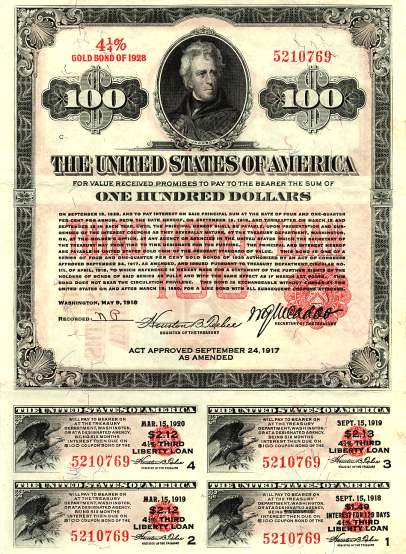|
Jul 28, 1914 |
World War I begins with Austria-Hungary's declaration of war against
Serbia. |
|
Jul 31, 1914 |
New
York Stock Exchange closes because of European Crisis. (Reopens Dec.
12). |
|
Aug 1914 |
Emergency currency is issued under Aldrich Vreeland Act. |
|
Aug 1, 1914 |
German declares war on Russia (France on Aug. 3, Britain on Aug. 4).
Austria-Hungary declares war on Russia and Japan declares war on
Germany in August. |
|
Nov 16, 1914 |
Federal Reserve Banks open for business. |
|
Jan 25, 1915 |
Telephone service begins between New York and San Francisco. |
|
Oct 15, 1915 |
U.S. bankers float $500 million loan to Britain and France at 5
percent. |
|
Sep 8, 1916 |
Emergency Revenue Act doubles income tax rates, adds estate tax and
munitions profits tax, and establishes Tariff Commission. |
|
Nov 7, 1916 |
Wilson is reelected as President. |
|
Feb 3, 1917 |
USS
"Housatonic" is sunk by German submarine, and U.S. breaks diplomatic
relations with Germany. |
|
Mar 3, 1917 |
Special Preparedness Fund Act provides for excess profit taxes and
higher inheritance taxes. |
|
Apr 2, 1917 |
Wilson calls special session of Congress for declaration of war
against Germany. (On April 4, Senate votes for war and house concurs
on April 6.) |
|
Apr 24, 1917 |
Emergency Loan Act authorizes issue of $5 billion in bonds at 3.5
percent. |
|
Jun 21, 1917 |
Federal Reserve Act is amended to encourage membership, mobilize gold
reserves, and facilitate issue of notes. |
|
Oct 1, 1917 |
Second Liberty Loan offers $3 billion in
bonds at 4 percent. |
|
Oct 3, 1917 |
War
Revenue Act doubles income taxes, provides for excess profits tax, and
imposes many excises. |
|
Nov 6, 1917 |
Russian Bolshevist overthrow Kerensky's Provisional Government,
placing Lenin in power. |
|
Dec 7, 1917 |
U.S. declares war on Austria-Hungary. |
|
Dec 26, 1917 |
The
U.S. Railroad Administration takes charge of the nation's railroads. |
|
Apr 5, 1918 |
Third Liberty Loan offers $3 billion in
bonds at 4.5 percent. |
|
Sep 28, 1918 |
Fourth Liberty Loan offers $6 billion in
bonds at 4.25 percent. |
The following was
reported in the News in
1917
LIBERTY LOANS
OF 1917.
On April 24 congress
passed an act
authorizing an issue
of $5,000,000,000
in bonds and $2,000,000
in certificates
of indebtedness.
The secretary
of the treasury
decided to place before
the country a
32.000,000,000 Issue
of bonds, in
addition to a certain
amount
of short term
certificates to meet the
needs
of the allies.
The announcement
of the initial
offer
of bonds was made
May 2 and the details
were made known May 14.
The bonds were dated
June 15,
1917, and bore
interest at the rate
of 314 per cent
per annum from that
date, payable
semiannually on Dec. 15
and June 15. They will
mature June 15, 1947,
but may be redeemed on
and after June 15, 1932,
in whole or in part, at
the option
of the
government. The bonds
are exempt, both as to
principal and interest,
from all taxation except
estate or inheritance
taxes. Provision was
made for converting the
3% per cent bonds
into bonds paying a
higher rate
of interest if
issued by the government
daring the war with
Germany. The dates for
paying for the bonds on
the installment plan
were: 2 per cent on
application; 18 per cent
June 28.
1917. 20 per cent
July 30, 30 per cent
Aug. 15 and 30 per cent
Aug. 30.
In floating the
loan Secretary
McAdoo took every mean*
to make it popular and
to clve every citizen
of the United
States an equHl
opportunity to subscribe
for the bonds. lie made
two trips through the
country in order
to explain the
necessities
of the
government, the great
value
of the bonds and
the wisdom
of the people
Investing In them.
The federal reserve
system afforded a great
Instrument for the
organization
of the necessary
machinery to distribute
Information, sell the
bonds and collect the
vast amount
of money placed
at the disposal
of the
government. The twelve
federal reserve banks,
which are the fiscal
agents
of the
government, became the
headquarters
of their
respective districts In
handling the lot n. The
direction
of the whole
operation was centered
In the treasury
department and the plan
of dealing with
the several districts
through the federal
reserve banks resulted
in the establishment
of a workable
organization that
handled the situation
expeditiously and
effectively. The
national banks, state
banks, trust companies,
private banks, bond
houses, newspapers,
express companies,
department stores and
many other private
corporations, firms,
organizations and
individuals
patriotically
co-operated with the
government to
receive and transmit
applications for the
liberty loan
without expense to the
United States or to the
applicants. Never before
was the whole machinery
of business and
enterprise organized
into a great voluntary
machine for service to
the country without
expectation
of compensation
or hope
of reward except
the satisfaction that It
contributed Immeasurably
to the success
of the greatest
loan In our
history, and thus to the
cause for which the
loan was made.
More than 4.000.000 men
and women subscribed for
tbe bonds and 99 per
cent subscribed in
amounts ranging from 160
to $10,000.
The second
liberty loan was
offered Oct. 1.
1917, the terms
being as follows: "The
secretary
of the treasury
invites
subscriptions, at
par and accrued
Interest, from the
people
of the United
States for
$3,000,000,000
of United States
of America 10-25
year 4 per cent
convertible gold 'bonds
of an issue
authorized by act
of congress
approved Sept. 24.
1917. the right
being reserved to allot
additional bonds up to
onehalf the amount
of any
oversubscription."
On Nov. 8 Secretary
McAdoo made the folic
wing announcement:
I congratulate the
American
people upon the
phenomenal success
of the second
liberty loan. The
final returns Just
received from the twelve
federal reserve banks
show that the total
subscriptions were
$4,617,632,300. an
oversubscription
of
$1,617,532,300. or
approximately 54 per
cent
of the amount
offered. This Is a more
gratifying result
even than was the first
liberty loan,
when
$2,000,000,000 of
bonds were offered and a
subscription
of more than
$3,000,000,000 was re
The treasury department
estimated that the
second
liberty lean was
subscribed to by
9,500000 persons and
corporations.
The following tables
show the treasury
allotment to each
federal reserve district
and th» actual
subscriptions:
FIRST
LIBERTY LOAN.
District Allotment
Subscriptions. New York
$600,000,000
$1,186,788,400
Chicago 260,000,000
Boston 240,000,000
Cleveland 180,000,000
Philadelphia 140,000,000
San Francisco
140,000.000
Richmond 80,000.000
Kansas City 100,000.000
St Louis 80,000,000
Minneapolis 80,000.000
Atlanta 60,000.000
Dallas 40,000,000
2.000,000,000
3,035,226,860
SECOND
LIBERTY LOAN.
District Allotment
Subscriptions.
Boston $300,000,000
$47l,960,060
New York 900,000.000
1,660,453.150
Philadelphia 250.000,000
380,350,250
Cleveland 300,000,000
486,106.800
Richmond 120.000,000
201,212.500
Atlanta 80,000,000
90,605.750
Chicago 420,000.000
685.853.351)
St Louis 120.000,000
184,280.750
Minneapolis
105,0(1(1,000
140.932.65J
Kansas City 120,000.000
150.125,760
Dallas 75,000.000
77.8S9.S50
San Francisco
210,000,000 292,671.160
Total 3,000,000,000
4,617,6S2,80»
LOANS TO ALLIED NATIONS.
Up to Dec. 10,
1917. the United
States had made the
following loans to the
allied nations:
Great Britain
$1,780,000,000
France 1,070,000,000
Italy 485.000,000
Russia 154.700,000
Belgium 47.000,000
Serbia ° 1.500.000
Romania 3,000.000
Total 3,541,200,000
|
|

To send us image scans by email, please send to the above email address.
To send us image scans by email, please send to the email address
below.

|




